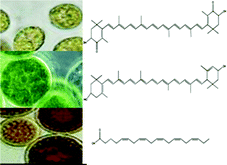The formation and accumulation of advanced glycation endproducts (AGEs) is a key pathophysiological process involved in various diabetic complications such as diabetic retinopathy. In the present study, for the first time, protective effects of three microalgal strains, including their extracts and active compounds, against both endogenous and exogenous AGEs in cell-based models were investigated. Results showed that in cultured human-derived retinal pigment epithelial ARPE-19 cells, the extract of Chlorella zofingiensis and its nutritional ingredient astaxanthin exhibited significant inhibitory effects on the formation of endogenous Nε-carboxymethyllysine (CML), a key AGE representative, through the suppression of intracellular oxidative stress. On the other hand, extracts of Chlorella zofingiensis, Chlorella protothecoides and Nitzschia laevis as well as their nutritional ingredients, namely astaxanthin, lutein and eicosapentaenoic acid (EPA), attenuated the deleterious effects induced by exogenous AGEs, such as cell proliferation and mRNA upregulation of vascular endothelial growth factor (VEGF) and matrix metalloproteinases (MMP)-2, which are critical steps involved in the pathogenesis of diabetic retinopathy. These results suggested the positive roles of astaxanthin, lutein and EPA in controlling the development of diabetes. These microalgae, therefore, might be regarded as beneficial foods and preventive agent choices for patients with diabetic retinopathy.

